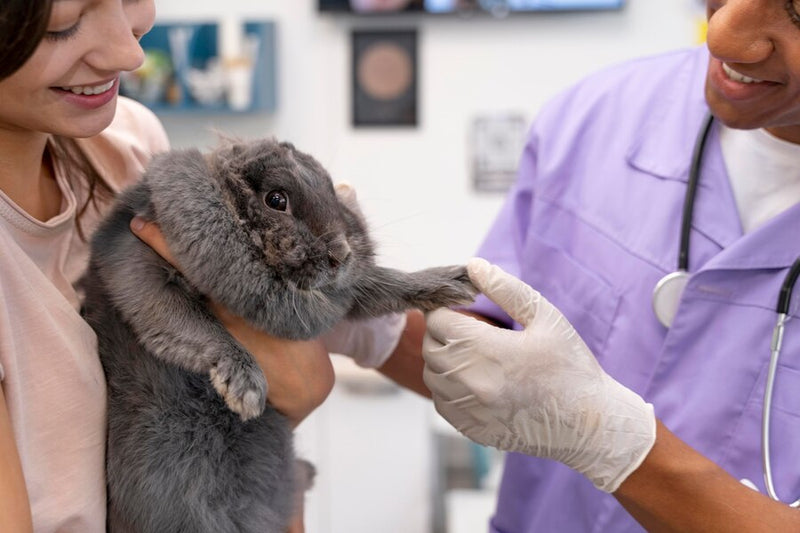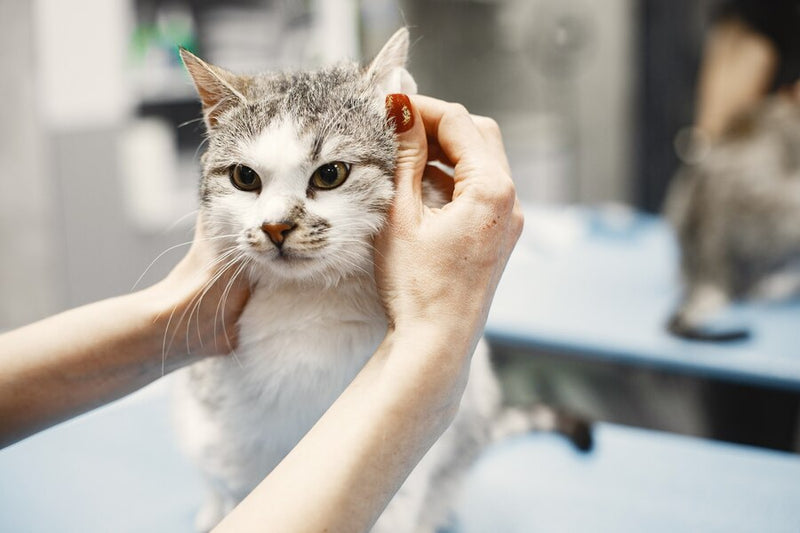
Welcome to Gritty Pet Co.
Your Canadian, specialty Pet Health & Wellness destination. 🇨🇦

Vet Reviewed & Approved
Dr. Ibrar A. is our veterinarian and a key member of our team. ✅
Microchipping pets is a simple, effective way to safeguard your furry friend. In minutes, a tiny chip under the skin provides permanent identification, which can be the difference between losing your pet forever or having them safely returned. This guide covers everything you need to know to make an informed decision.
Key Takeaways
Microchipping is a simple yet powerful tool to keep your pets safe. Here’s what you need to know:
Permanent Protection: Microchipping provides lifelong identification for your pet, making it much easier to reunite if they ever get lost. Unlike collars or tags, a microchip stays with your pet, ensuring they can always find their way back to you.
Simple and Safe: The microchipping process is quick, painless, and safe . It’s as simple as a routine vaccination and rarely causes complications. The procedure may cause minimal discomfort to your pet, but the recovery time is negligible.
Stay Updated: Your pet’s microchip is only as good as the information linked to it. Always update your contact details whenever you move or change phone numbers. This ensures you’ll be contacted immediately if your pet is found, minimizing time apart and stress for both of you.
For those wanting a deeper understanding, here’s what you need to consider:
Legal & Privacy Considerations: Microchipping laws and privacy concerns vary by region. Some areas may require microchipping by law, and it’s important to be aware of how your personal information is handled. Stay informed to ensure you’re compliant and comfortable with how your data is used.
Technology & Limitations: Microchips rely on access to scanners and databases for effectiveness. While most urban areas are well-equipped, some rural regions may lack the necessary technology, potentially limiting the chip’s usefulness.

One of the most effective ways to protect your pets from getting lost or separated is through microchipping. Picture this: your adorable pup or adventurous kitty sneaks through an open gate and wanders a bit too far from home. In such cases, a microchip can be their lifeline, enabling swift identification and reunion with their human family.
Microchipping pets is a common practice that involves implanting a tiny electronic chip under the skin of a pet, typically between the shoulder blades. Learn everything you need to know about microchipping pets and how to keep your beloved furry friends safe and sound.
Pros and Cons of Microchipping Your Pet
While microchipping offers several benefits, it's essential to consider both the pros and cons, weighing safety against potential health risks.
Pros:
Permanent Identification : Unlike collars and tags, which can be lost or removed, a microchip provides a permanent form of identification for your pet. This ensures that even if your pet gets lost or stolen, they can be easily identified and reunited with you.
Increases Chance of Return : Microchipping significantly increases the chances of a lost pet being returned to its owner. Animal shelters, veterinary clinics, and animal control agencies routinely scan lost pets for microchips and can quickly contact the owner using the information stored in the chip's database.
Quick and Painless Procedure : The microchipping procedure is quick, typically done within minutes, and relatively painless for the pet. It requires no anesthesia and is similar to a routine vaccination injection.
Widely Accepted : Microchipping is widely accepted and recommended by veterinary professionals, animal welfare organizations, and government agencies as a reliable form of pet identification.
Cons:
Potential Health Risks : While adverse reactions to microchips are rare, there have been reports of pets experiencing complications such as inflammation, infection, or even tumor formation at the implantation site. However, these occurrences are extremely rare, and the overall risk is considered low.
Dependence on Scanners : The effectiveness of microchipping relies on the availability of microchip scanners and access to the appropriate database. In some areas, especially rural or underdeveloped regions, these resources may be limited, reducing the chances of a lost pet being reunited with its owner.
Privacy Concerns : Some pet owners have raised concerns about privacy and data security related to microchipping. They worry about the potential misuse of their personal information stored in the microchip database or the tracking of their pet's movements.
Microchip Mechanics: How it Works, Identification
Microchips are small electronic devices, about the size of a grain of rice, that contain a unique identification number. This number is stored in the chip's memory and can be read using a microchip scanner.
When a scanner is passed over the area where the microchip is implanted, it emits a radio frequency signal that activates the chip, allowing the identification number to be displayed on the scanner's screen. This number is linked to the pet owner's contact information in a database, enabling quick and easy identification of lost or stolen pets.
Procedure Details: Safety, Types, Post-Care
The microchipping procedure is quick, minimally invasive, and typically done without anesthesia. A veterinarian or trained professional inserts the microchip under the pet's skin, usually between the shoulder blades, using a hypodermic needle. The process is similar to a routine vaccination injection and causes minimal discomfort for the pet.
There are different types of microchips available, but most operate on the same frequency and can be read by universal scanners. After the procedure, it's essential to monitor the implantation site for any signs of infection or inflammation. Pets should avoid excessive activity for a few days following the procedure to allow the implantation site to heal properly.
Registration & Databases: Importance of Updates
Registering your pet's microchip and keeping your contact information up to date is crucial for ensuring a swift reunion if your pet ever becomes lost. Many microchip manufacturers provide online registration services where pet owners can enter their contact information and link it to their pet's microchip number. It's essential to update this information whenever you move or change phone numbers to ensure that your pet's microchip remains effective.

Legal/Ethical: Region Laws, Privacy Concerns
Microchipping laws and regulations vary by region, so it's essential to familiarize yourself with the requirements in your area. Some regions may mandate microchipping for certain types of pets or require registration with specific databases.
Also, there are privacy concerns related to microchipping, such as the potential misuse of personal information stored in the microchip database or concerns about tracking pets' movements. It's essential for pet owners to understand the legal and ethical implications of microchipping and advocate for their pet's best interests.
Microchip Cost in Canada
Microchipping your pet in Canada can come with different price tags depending on where you are. Each veterinary clinic sets its own fees for the procedure, so it's best to contact your local clinic for an accurate cost estimate. Some clinics might offer discounts for spayed or neutered pets, and others may bundle microchipping with spaying or neutering services for added convenience and savings. The costs at various clinics throughout Canada varies, approximately between $30 to $100.
The cost can vary depending on factors such as the type of microchip used, the veterinarian's fees, and any additional services provided. Always look for reputable providers that offer transparent pricing and quality care for your pet.
Type of Microchip : There are different types of microchips available, each with its own features and capabilities. Basic microchips may be more affordable, while advanced microchips with additional functionalities, such as temperature monitoring or GPS tracking, may come at a higher cost.
Veterinary Fees : The cost of microchipping often includes the veterinarian's fees for the implantation procedure. Veterinary fees can vary depending on factors such as the clinic's location, reputation, and any additional services provided during the appointment.
Registration Fees : Some microchip manufacturers or registration databases may charge a separate registration fee to link your contact information with your pet's microchip number. These fees can vary depending on the registration service chosen and whether it's a one-time or recurring fee.
FAQ
How Do I Update My Pet's Microchip Information?
It's crucial to keep your pet's microchip information up to date. Most microchip databases provide online portals where pet owners can register their pet's microchip and update their contact information as needed. Additionally, you can contact the microchip manufacturer or your veterinarian to update your pet's information in the database.
2. At What Age Should I Microchip My Pet?
Pets can be microchipped at any age, but most veterinarians recommend microchipping puppies and kittens as early as possible. Some shelters and breeders may even microchip pets before adoption.
3. Do Microchips Require Maintenance or Replacement?
Microchips are designed to last a lifetime and typically do not require maintenance or replacement.
4. Does Microchipping Hurt My Pet?
The microchipping process is typically painless, causing no more discomfort than a standard vaccination. Pets usually don’t even flinch during the procedure, and the chip is designed to last a lifetime without needing maintenance or replacement. You can rest assured your pet won’t suffer from it.
5. Why Should I Microchip My Pet?
Microchipping provides a permanent form of identification, significantly increasing the chances of reuniting with your pet if they get lost. Unlike collars or tags that can be removed or lost, a microchip stays with your pet for life, offering peace of mind and security in stressful situations.
Top YouTube Videos on Microchipping Pets
1. Why You Should Microchip Your Dog | 3 Life Saving Reasons
Why Watch: This video highlights three crucial reasons to microchip your dog, providing real-life scenarios where microchipping could save your pet's life.
2. How Do Pet Microchips Work?
Why Watch: This video breaks down the science behind pet microchips, explaining how they function to help reunite lost pets with their owners.
3. How to Microchip a Dog
Why Watch: This video provides a step-by-step guide on how microchipping is done, offering a clear view of the procedure.
Final Thoughts
Microchipping your pet is one of the simplest yet most effective ways to ensure their safety and well-being. While the initial cost of microchipping your pet may seem like an expense, consider the long-term benefits of having a reliable form of identification for your pet. The peace of mind knowing that your pet can be quickly reunited with you if lost or stolen may outweigh the upfront cost.
















